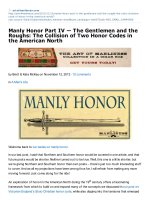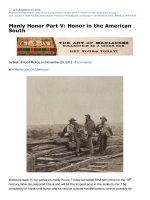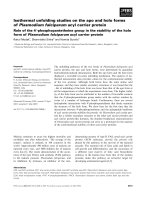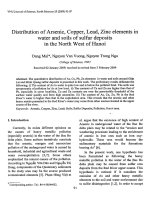4 7 conflict in the american west
Bạn đang xem bản rút gọn của tài liệu. Xem và tải ngay bản đầy đủ của tài liệu tại đây (3.67 MB, 10 trang )
Fascinating Facts
• United States soldiers took the same route that
Spanish explorer Hernando Cortés and his men
had taken more than three hundred years before to
defeat the Aztec Empire.
CONFLICT
IN THE
AMERICAN WEST
• Zachary Taylor was not the only President who
served in the Mexican War. Ulysses S. Grant and
Franklin Pierce also served in that war.
• After the Mexican War, many people in Latin
America called the United States “El Coloso del
Norte,” or the colossus of the North.
Genre
Nonfiction
Comprehension Skill
Compare and
Contrast
Text Features
• Map
• Chart
• Captions
Scott Foresman Social Studies
BY RENA KORB
ISBN 0-328-14863-6
ì<(sk$m)=beigdj< +^-Ä-U-Ä-U
Between 1846 and 1848, the United States and Mexico
fought a bloody, bitter war. At stake was both pride and
land. After winning every major battle, the United States
defeated Mexico and gained more than half a million
square miles of land. In this book you will learn about
the Mexican-American War and the way it changed the
landscape of the United States.
Write to It!
The United States had many reasons for
wanting to go to war with Mexico. However,
Polk asked Congress for a declaration of war
based only on Mexico’s attack of United
States soldiers on the eastern side of the Rio
Grande. Do you think the United States had
a good reason for going to war? Explain your
answer in one or two paragraphs.
CONFLICT
IN THE
AMERICAN WEST
Vocabulary
boundary
province
annex
manifest destiny
invade
rebellion
negotiations
cession
Write your paragraphs on a separate sheet
of paper.
BY RENA KORB
Maps
MapQuest, Inc.
Photographs
ISBN: 0-328-14863-6
Copyright © Pearson Education, Inc.
All Rights Reserved. Printed in the United States of America. This publication is protected
by Copyright, and permission should be obtained from the publisher prior to any prohibited
reproduction, storage in a retrieval system, or transmission in any form by any means,
electronic, mechanical, photocopying, recording, or likewise. For information regarding
permission(s), write to: Permissions Department, Scott Foresman, 1900 East Lake Avenue,
Glenview, Illinois 60025.
1 2 3 4 5 6 7 8 9 10 V0G1 14 13 12 11 10 09 08 07 06 05
Every effort has been made to secure permission and provide appropriate credit for photographic material. The publisher deeply
regrets any omission and pledges to correct errors called to its attention in subsequent editions.
Unless otherwise acknowledged, all photographs are the property of Scott Foresman, a division of Pearson Education.
Photo locators denoted as follows: Top (T), Center (C), Bottom (B), Left (L), Right (R) Background (Bkgd)
Opener: ©Getty Images Editorial Offices: Glenview, Illinois • Parsippany, New Jersey • New York, New York
2 ©North Wind Picture Archives
6 ©North Wind Picture Archives
Sales Offices: Needham, Massachusetts • Duluth, Georgia • Glenview, Illinois
8 ©The Granger Collection,
NY
Coppell,
Texas • Sacramento, California • Mesa, Arizona
10 ©Getty Images
13 ©Getty Images
War Breaks Out
In April 1846 trouble was brewing along the banks
of the Rio Grande in Texas. Mexican armies and
United States troops had gathered on opposite sides
of this mighty river. Why? According to the United
States, the Rio Grande marked the boundary, or
border, between the two countries. According to
Mexico, however, the boundary stood at the Nueces
River. The Nueces lay about one hundred miles to
the northeast. Now each army stood prepared to
defend this territory.
At the end of March 1846, General Taylor’s 3,500 troops
began building forts along the Rio Grande, right across from
the Mexican city of Matamoros.
2
On April 25 the Mexican commander sent a large
force across the river. The Mexican troops surrounded
a group of United States soldiers. In the skirmish,
sixteen Americans were killed or wounded. The
Mexicans also took some soldiers as prisoners.
General Zachary Taylor, who later became President
of the United States, was in charge of United States
forces in Texas. He sent word to President James K.
Polk, saying, “Hostilities may be considered to have
commenced.” Polk immediately went to Congress,
and on May 13, 1846, the United States declared war
against Mexico.
The Road to War
Several events led to the outbreak of the Mexican
War. In 1821 Mexico had gained independence from
Spain and gained control of Spain’s enormous land
holdings in North America. Some of these lands became
Mexican provinces of New Mexico, California, and
Texas.
Many settlers in Texas, however, disliked Mexican
rule. In 1836 following their victory in the Texas
Revolution, they declared independence and formed
the Republic of Texas. Mexico still thought of the area
as its own. Then in 1845 the United States annexed
Texas. This action increased tensions between the
United States and Mexico.
3
Opposition to the War
Not all Americans supported the war with Mexico.
Some United States senators agreed with Mexico
that the boundary between the two countries stood
at the Nueces River, not the Rio Grande. This meant
that Taylor’s army had been trespassing on Mexican
land, and Mexico’s army was only defending its
territory. Also, people who opposed slavery generally
opposed the war. They believed that if the land in
the Southwest became states, slavery would become
legal there.
Many Americans had come to believe in the idea
of manifest destiny, meaning that the United States
should extend to the Pacific Ocean. Britain blocked
the expansion in the Northwest with its claims on
Oregon Territory. This issue was settled in 1846,
with the United States gaining full rights to presentday Oregon and Washington state. New Mexico,
California, and Texas were provinces of Mexico.
The United States tried to buy this land in 1845.
Polk sent agent John Slidell to Mexico. Slidell offered
to pay as much as $30 million for Mexico’s northern
provinces, where few Mexicans lived. However, the
mention of Slidell’s visit in a Mexican newspaper led
to a huge cry of protest from many Mexicans. The
Mexican government refused to even see Slidell. Now
there seemed little chance of getting the land other
than taking it by force. With the incident in Texas, the
United States had a reason it needed to go to war.
4
The Invasion of Mexico
Because many people in the United States opposed
the Mexican War, Polk wanted to win it quickly.
Military commanders developed a strategy to attack
many locations in Mexico at once. One division
would invade Mexico, while other forces would
march on New Mexico and California.
Even before news of the war reached Texas, General
Taylor’s troops had engaged in several battles and
defeated the Mexican forces. Taylor then crossed the
Rio Grande and entered Mexico. On May 18, 1846,
only one week after the war broke out, Taylor had
his first major victory when he captured the town of
Matamoros. The Mexican army had abandoned the
town before the arrival of the troops, so no fighting
took place. Taylor then raised the American flag over
the town.
Advantages in Fighting the Mexican War
American Advantages
• Better weapons
• Better military leaders
•
Better-trained soldiers
Mexican Advantages
• Three times more soldiers
• Possible aid from Great
Britain and France
• Disapproval of the war
by many Americans
5
The Conquest of New Mexico
At the same time, United States troops were
advancing on the Mexican provinces in the Southwest.
In June 1846 Colonel Stephen Kearney led about
1,500 troops westward from Kansas along the Santa
Fe Trail. They were headed to New Mexico’s capital,
Santa Fe. As they traveled, Kearney and his troops
claimed the towns they passed. He made speeches and
posted signs in English and Spanish, explaining that
the land now belonged to the United States.
Colonel Stephen Kearney captured the Mexican province
of New Mexico.
After about two months of marching, in August
Kearney and his men reached Santa Fe. New Mexico
had gathered an army. However, these defenders
had left their posts before the two armies even met.
Kearney raised the American flag over the city and
announced the annexation of New Mexico to the
United States.
Most New Mexicans accepted United States control
of the region. However, in January 1847, a group of
New Mexicans started a rebellion in Taos, where the
American governor was staying. They killed him along
with six other men and planned to attack Santa Fe
next. The rebels barricaded themselves in the nearby
town of Taos Pueblo. After seven hours of battering
the town’s walls, the troops broke through. The rebels
surrendered and the United States army had put down
the rebellion. New Mexico was now under United
States control.
The Bear Flag Revolt
By the summer of 1846, California was also in a
state of disorder. Although about five hundred settlers
from the United States lived in California compared
with about eight thousand Mexicans, or Californios,
the settlers decided they no longer wanted to be
under Mexico’s control. In 1846 a United States Army
captain named John C. Fremont encouraged a small
group of settlers in northern California to rebel.
6
7
The Conquest of California
On June 14 a small group of settlers rose up in the
settlement of Sonoma. They arrested the Mexican
army commander and captured weapons. They then
wrote their declaration of independence from Mexico.
Since news of the war’s outbreak had not yet reached
California, they could not claim the land for the
United States. Instead, they declared California to be
the Bear Flag Republic.
The settlers only had shaky control of northern
California, but more soldiers were on the way. In
July 1846 the first navy troops landed in California.
Soldiers quickly fanned out. Some went north and
took over the region claimed by the Bear Flag rebels.
Others went south and captured Los Angeles and San
Diego. The soldiers were successful. After about a
month, the soldiers were so confident of victory that
commanders sent a scout back to Washington, D.C.,
with news of their possession of California.
The military commanders, however, had a difficult
job ahead of them. They had the support of only a
few hundred soldiers, and they were enforcing harsh
rules. For instance, they made many Californios obey
a curfew and refused to allow them to carry weapons.
The Californios rebelled. By mid-December they
had regained control of most of southern California,
including the coastal prize of Los Angeles.
Around that time, Colonel Kearney and his army
arrived in San Diego. They marched toward Los
Angeles and beat back two strong enemy attacks on
the edges of the city. With these additional troops,
United States forces put down the rebellion in
January. The conquest of California was over.
8
9
The Bear Flag Revolt drew its name from the flag the settlers
hastily made, which pictured a grizzly bear.
Taylor’s Campaign in Mexico
Meanwhile, the war continued to unfold to the
south. In September 1846, General Taylor led about
six thousand soldiers to Monterrey, the largest city
in northern Mexico. Monterrey was nestled between
a mountain and several hills. On top of these hills,
the Mexicans had built forts armed with guns and
cannons. The United States troops scrambled up the
hills in the face of Mexican soldiers shooting down
on them. After several attempts, the troops made it to
the top and captured the forts. They were now able
to enter the city. Still, the Mexican forces did not give
up. They took cover in Monterrey’s stone houses. The
American troops were forced to fight them house
by house in the streets. After several days of fierce
fighting, Monterrey fell to American troops.
The battle for Monterrey had killed or wounded
more than five hundred of Taylor’s men. The
Mexicans had been weakened as well. So Taylor and
the Mexican army agreed to an eight-week halt to the
fighting. The Mexican forces left the city, and Taylor’s
troops remained in Monterrey. Several months later,
in January 1847, Mexico decided to retake the city.
About twenty thousand Mexican troops began a
240-mile march north. They hoped to defeat Taylor’s
forces of about five thousand troops. For nearly a
month, they struggled through the dry, harsh country.
Learning that the Mexicans would be attacking
soon, Taylor and his men took up a position at Buena
Vista, a location near Monterrey. The Mexican army
arrived, and the battle broke out. After a few days of
hard battle, neither side appeared close to a victory.
The American troops were vastly outnumbered
and held little hope that any reinforcements would
arrive. After the second day of battle, the troops went
to sleep in the rain. They expected to face another
fierce struggle the next day, but to their surprise, they
awoke to find that the Mexican troops had vanished.
The Battle of Buena Vista marked the last skirmish
in northern Mexico. Soon the fighting shifted to the
central part of the country.
General Zachary Taylor and his forces
captured Monterrey.
11
Conquest in the Heart of Mexico
Despite the United States’ victories at Monterrey
and Buena Vista, the Mexican troops showed no signs
of giving up. Many U.S. military leaders believed that
the only path to victory lay at the end of the road in
Mexico City, the capital. They planned their attack
when they knew that most of the Mexican troops
were still several weeks’ march to the north.
In the early part of March 1847, about ten
thousand American troops sailed to the Mexican
coast, landing a few miles from the city of Veracruz.
They left their boats and waded ashore. They
bombarded the city with cannon fire. Thirty-twopound cannonballs arched over the walls of Veracruz,
tearing through roofs and landing in many homes.
While Mexican soldiers returned fire, the townspeople
took refuge in churches and in underground storage
rooms. Within a few days, the cannonballs had blown
a hole in the city’s wall. On March 26, 1847, the city
fell to American troops.
One week later, American soldiers began the
difficult 265-mile march to Mexico City. They fought
back the Mexican forces that tried to stop their
journey. However, most of the towns were undefended
and surrendered without a struggle.
12
By early September, the United States forces had
gathered near the gates of Mexico City. As part
of their strategy, they first attacked an old castle
in Chapultepec, which stood outside the city. It
was being used as a Mexican military school. The
fighting lasted several hours, and included hundreds
of young military students. But after bloody handto-hand fighting, the Mexicans fled. By the morning
of September 13, the battle was over. On September
14, 1847, United States forces entered the capital.
Mexicans watched from their windows and rooftops
as the troops entered their city. The Mexicans flew the
white flag of surrender. An American flag waving over
the capital soon replaced it.
Today, Mexicans remember several cadets who fought to the
death at Chapultepec as Los Niños Heroes, or “the Boy Heroes.”
The Peace Treaty
With the fall of the capital, the Mexican War
ended. All that remained was setting the terms of
peace. Nicholas Trist, a United States agent, began
negotiations with the Mexican government. In a
town near Mexico City, Trist and Mexican leaders
came to an agreement known as the Treaty of
Guadalupe Hidalgo. In return for $15 million dollars,
the United States gained Mexico’s northern provinces.
Mexico also accepted the United States’ annexation of
Texas, and the countries agreed that the Rio Grande
now served as their boundary.
As result of the Mexican War, the United States
gained more than half a million square miles of
land, known as the Mexican Cession. A cession is
the giving up of territory by one country to another
country. This enormous piece of land includes
present-day California, Nevada, Utah, and parts of
Arizona, New Mexico, Colorado, and Wyoming. The
United States had grown with one treaty to almost the
size of Europe.
Only six years later, in 1853, the United States and
Mexico made another treaty. The Gadsden Purchase
gave the United States an additional thirty thousand
square miles of territory in northern Mexico in return
for $10 million. Today, this land makes up portions of
southern Arizona and New Mexico.
14
Life in those former Mexican provinces soon
changed. Thousands of Mexicans who lived there
became United States citizens. Settlements grew,
particularly after the discovery of gold in northern
California in 1848. Over the next few years, tens of
thousands of people from around the world moved
to California with hopes of finding riches in gold.
With a growing western population, the United States
had finally fulfilled its manifest destiny and stretched
“from sea to shining sea.”
United States Expansion in the Southwest
CANADA
MEXICAN CESSION
1848
PACIFIC
OCEAN
Present-day
boundaries
are shown.
GADSDEN
PURCHASE
1853
UNITED STATES
ATLANTIC
OCEAN
TEXAS
1845
N
Gulf of Mexico
0
200
400 Miles
MEXICO
0
15
200
400 Kilometers
Between
1846 and 1848, the United States and Mexico
Glossary
fought a bloody, bitter war. At stake was both pride and
land.
After
every major battle, the United States
annex
to winning
add or attach
defeated Mexico and gained more than half a million
boundary a line or natural feature that separates one
square miles of land. In this book you will learn about
area or state from another
the Mexican-American War and the way it changed the
cession of
thethe
giving
up of
territory by one country to
landscape
United
States.
another country
invade to enter by force in order to attack or conquer
Vocabulary
manifest destiny the belief that the United States
boundary
should expand west to the Pacific Ocean
province
negotiations the process of working with others to
come to an agreementannex
on an issue
manifest
destiny
province a territory
governed
by a country or empire
invade
rebellion open and armed
resistance to a government
rebellion
negotiations
cession
Write to It!
The United States had many reasons for
wanting to go to war with Mexico. However,
Polk asked Congress for a declaration of war
based only on Mexico’s attack of United
States soldiers on the eastern side of the Rio
Grande. Do you think the United States had
a good reason for going to war? Explain your
answer in one or two paragraphs.
Write your paragraphs on a separate sheet
of paper.
Maps
MapQuest, Inc.
Photographs
Every effort has been made to secure permission and provide appropriate credit for photographic material. The publisher deeply
regrets any omission and pledges to correct errors called to its attention in subsequent editions.
ISBN: 0-328-14863-6
Copyright © Pearson Education, Inc.
All Rights Reserved. Printed in the United States of America. This publication is protected
by Copyright, and permission should be obtained from the publisher prior to any prohibited
reproduction, storage in a retrieval system, or transmission in any form by any means,
electronic, mechanical, photocopying, recording, or likewise. For information regarding
permission(s), write to: Permissions Department, Scott Foresman, 1900 East Lake Avenue,
Glenview, Illinois 60025.
1 2 3 4 5 6 7 8 9 10 V0G1 14 13 12 11 10 09 08 07 06 05
16
Unless otherwise acknowledged, all photographs are the property of Scott Foresman, a division of Pearson Education.
Photo locators denoted as follows: Top (T), Center (C), Bottom (B), Left (L), Right (R) Background (Bkgd)
Opener: ©Getty Images
2 ©North Wind Picture Archives
6 ©North Wind Picture Archives
8 ©The Granger Collection, NY
10 ©Getty Images
13 ©Getty Images









